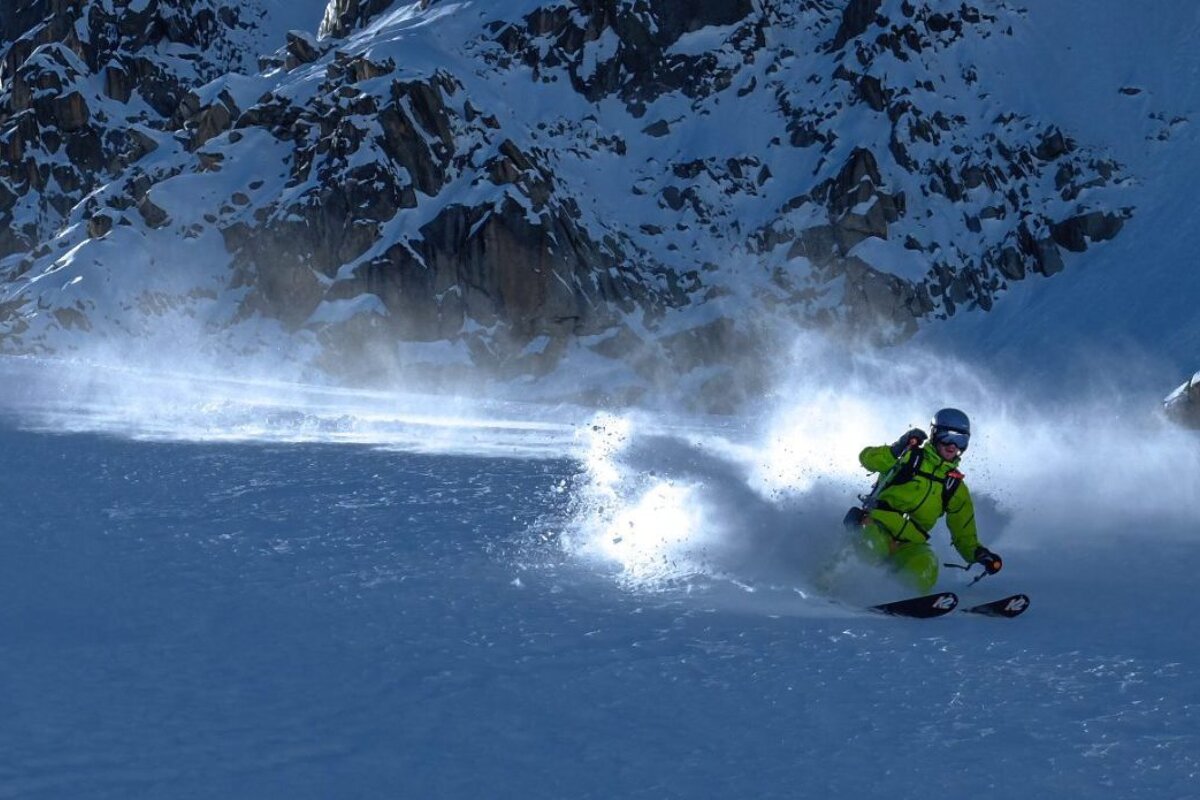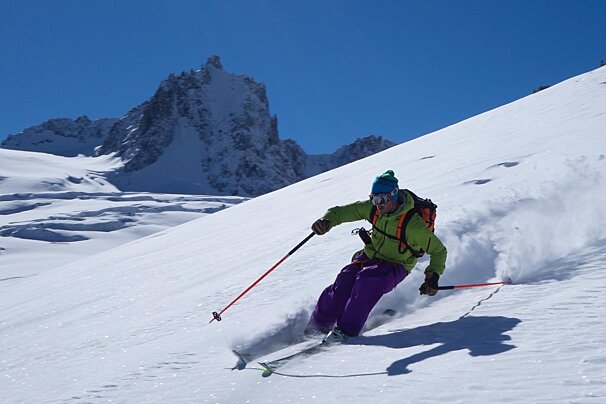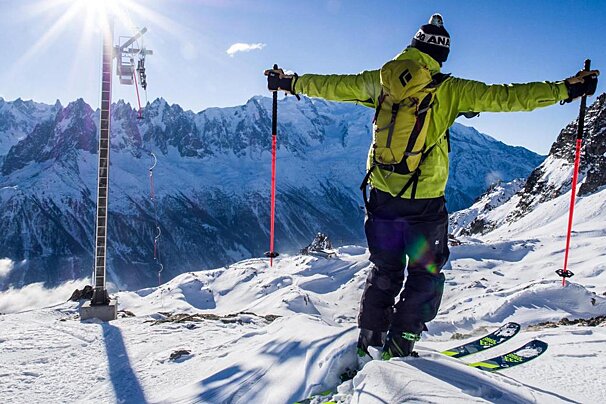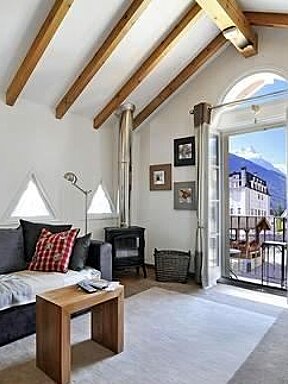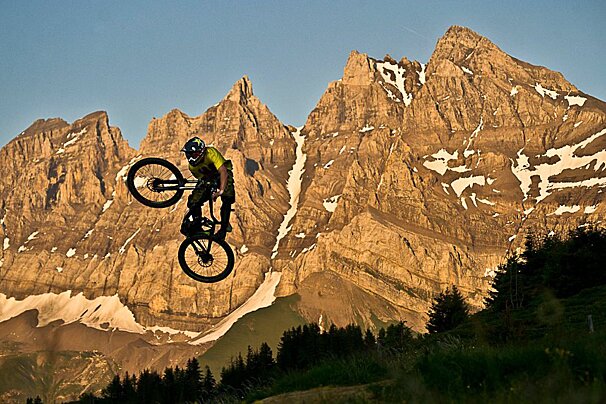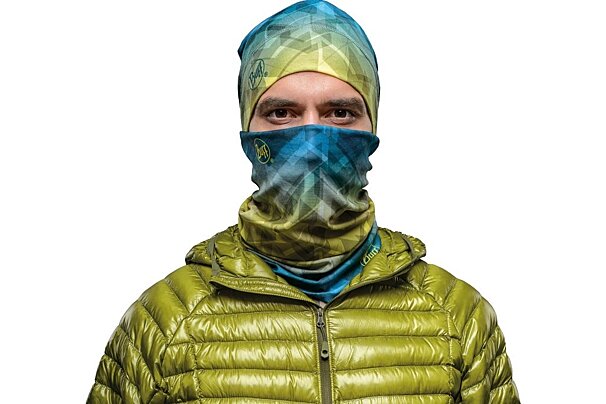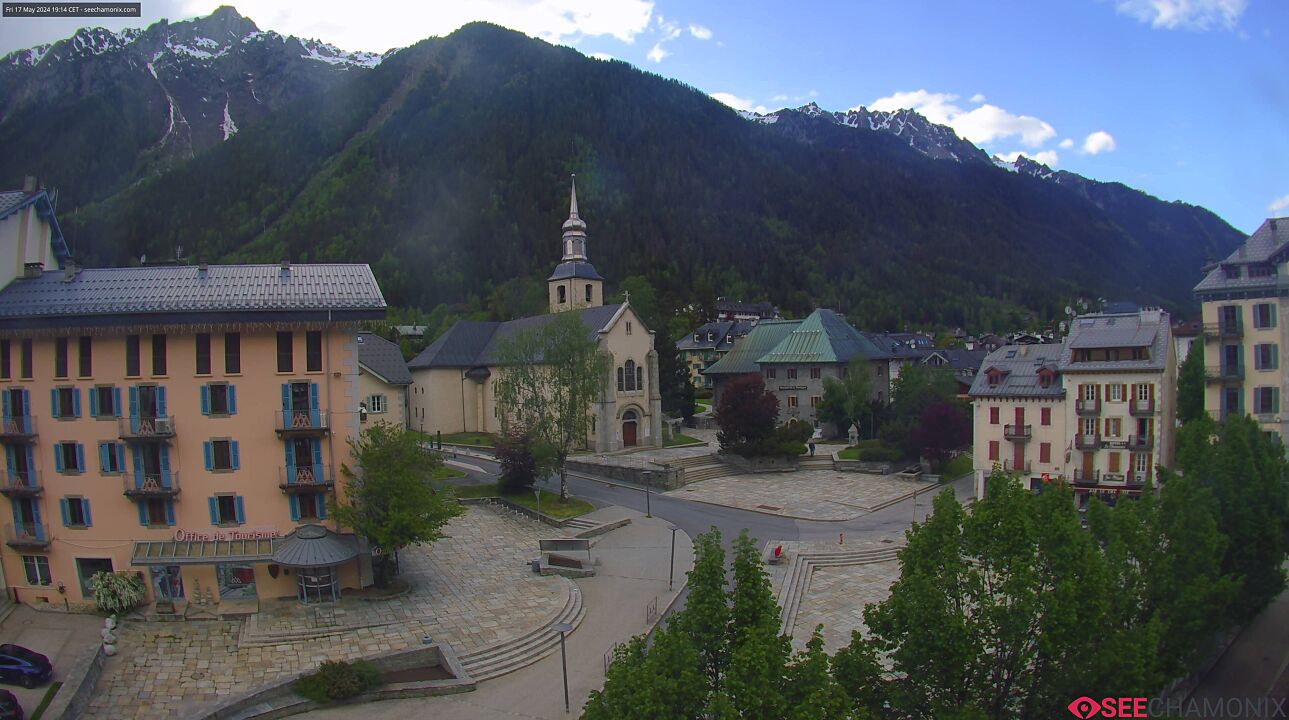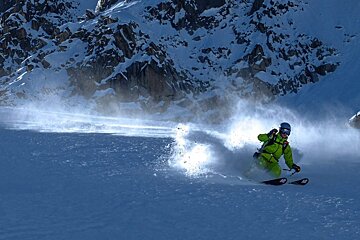
© Luke Jarmey
Off-piste ski areas in Chamonix
Discover the top Chamonix off-piste skiing
Chamonix's off-piste and backcountry skiing is legendary, offering some incredibly challenging and steep routes for skiers, snowboarders and mountaineers, bringing people here from around the world.
Off-piste in Chamonix isn't reserved solely for the advanced though. You can take advantage of some easily accessible sections between the pistes, and with merely a short hike up or a small traverse across a piste you can enjoy some lovely powder and fun off-piste terrain at Grands Montets, Brévent and Flégère, Le Tour/Balme, Vallorcine and even at Les Houches.
Always make sure you are prepared before embarking on off-piste skiing or snowboarding, check out our Avalanche Safety page before setting off. It is also always advisable to hire an off-piste guide who will have extensive knowledge of the area and the mountains.
Please note: you ignore safety warnings and barriers/ropes and undertake off-piste skiing/boarding at your own risk. We always recommend that you take a mountain guide when heading off-piste.
Watch this

La Vallée Blanche off-piste route
The 'Vallée Blanche' is an unmarked, unmaintained and unpatrolled high mountain off-piste ski itinerary which offers some of the most spectacular scenery that the Mont Blanc range has to offer. Accessed from the top of the Aiguille du Midi cable car, this exceptional ski run should be undertaken with a qualified mountain guide.
Starting at the top of the Aiguille du Midi (3,812m), after exiting the ice tunnel you are straight onto the 'arête'. One of the most dangerous parts of the entire route, this is a ridge with a 50-degree pitch on both sides that in high season has a rope and steps cut into the ice, but even so it's pretty intimidating when you look down.
There are four 'Classic' routes: The Classic Route aka Voie Normale, Le Vrai Vallée Blanche, the Petit Envers du Plan and the Grand Envers du Plan. The latter routes are technically more challenging so demand a more experienced skier/snowboarder.
The VB is a highlight of many tourists' ski trip to Chamonix, and with breaks for lunch/snacks and some time for photos it generally takes between four to six hours to make the round trip. The route out is a long flat run, so snowboarders should come armed with telescopic poles.
You will need to wear a harness when skiing on the glacier, to allow for crevasse rescue (your guide should carry any required rescue equipment and know the correct method of performing crevasse rescue). Plus you should wear a transceiver, and hopefully it goes without saying, but make sure you know how to use it, and you'll need shovels and probes. There are very real dangers up here, so this descent should not be taken lightly and we highly recommend you employ the services of a professional guide.
We've written a comprehensive guide to the Vallée Blanche, so for more details please follow the link below.
Off-piste skiing in Brévent and Flégère
The locals favourite, the Brévent and Flégère ski areas offer some great terrain for off-piste skiing, with steep couloirs and natural bowls that are surprisingly easy to access. As with all off-piste riding, you should be equipped and know what you're doing.
Brévent
One favourite off-piste area is the ridge at the top of Brévent, which requires a little bit of hiking, but then gives you the option of dropping into various steep chutes above the Charles Bozon piste. The steepness of these chutes makes them avalanche prone so take care. Falling here could result in a drop over cliffs, or an avalanche that could take out skiers below.
You get to this area by taking the top Brévent cable car and then following the Bozon run down until it turns sharply to the right. Here, take a left under the avalanche warning rope; passing this means you need to be responsible for yourself and others, be equipped and know what you’re doing. Following the ridge, there are a few sections that go uphill and so you'll have to walk a little bit. Depending how far you go there are various narrow couloirs that drop down to the right. After a 10-15 minute hike along the back of the ridge you reach the Col de Brévent, an open col with views on the right down to the Bozon piste and Chamonix Village immediately below - another one of our favourite runs with plenty of steep and deep stuff to amuse you.
The snow is usually good here for a few days after a fresh dump but will get unstable if the sun gets to work on it and the temperature rises, so you shouldn't do this run late in the afternoon on warm days. In the spring you’ll see the pisteurs setting off controlled avalanches on these slopes.
Flégère
The terrain of Flégère is also superb for off-piste skiing. The main bowl offers some of the best freeride terrain that Chamonix has on offer. The natural undulating terrain makes it great for natural table tops, quarter pipes and half pipes and in fact, the whole bowl is pretty much rideable with only a few exceptions. The snow often remains very good at this altitude, however, it is good to stay alert as this section has hidden rollovers, some of which lead onto very large cliff drops so we recommend that you don’t go skiing over things before you’ve checked where they go. Only enter this off-piste area in good visibility and once you already have a good idea of where you are going.
Route 1: Combe Lachanel - On a fresh powder day, it is best to try and catch the first cable car up from Les Praz to get those all important first tracks. The Index chairlift makes getting into the Combe Lachenal easy, as it drops you right at the top of the bowl. Take a left (skier’s right) from the chairlift into the bowl, pay attention to any warning barriers as this area is avalanche prone. Make sure you are fully equipped, trained and avalanche aware.
The bowl is vast with only one piste running down the middle. You can select to traverse out either left or right to get fresh tracks, and generally, it takes a long time before this bowl is truly tracked out. If you traverse out skiers’ right be sure not to go so far that you can’t get back to the piste at the bottom that will take you back to the Evettes chairlift (you may find yourself heading down to Les Praz via the main avalanche chute if you stray too far off the beaten track!).
If you traverse left about halfway down you’ll find a small hidden bowl that keeps the ‘freshies’ longer than the main bowl. The terrain is great for freeriding with wide open sections at the top. Lower down there are small chutes and drops to the right, rollers and trees to the left.
Route 2: The Index - The area to the right (skier’s left) of the Index chairlift also has some superb off-piste with longer runs possible. Head out below the old Index lift building and work your way down the mountain. Along here you’ll find cornices where you can drop in, and wide open slopes where you can let rip before heading down towards the Trappe chairlift that takes you back to the Index lift.
Route 3: Floria - The area between the Floria piste and the Pylones piste is a massive ungroomed area that has enough excitement to keep you coming back run after run, each time discovering another hidden stash of fresh snow. You can also access some of the great off-piste conditions to the right of the Index chair by using access from the bottom of the Floria lift. We would reiterate that we are extremely careful in this sector above the Chavanne chairlift as this area has many roll overs as we discussed above, some of which lead to large cliff drops. Make sure you can see your route down the mountain before you take off at top speed.
Route 4: The Trappe - If you’re trying off-piste for the first time, the area under the Trappe chair has some fun terrain. Trees and good snow will give you a very nice taste of the off-piste without straying too far from the green runs.
Above the Trappe green run, there are a couple of steep, narrow couloirs visible to the right as you get to the top on the ride up the Trappe chairlift. They start out wide and flat but quickly become steep and narrow, so probably best not attempted if the snow is hard and icy, but in good snow they offer a real buzz and are a true technical test of your ability. We get to these from the Pylones piste, by heading skier's left just before you get to the flat section near the bottom of the run.
Off-piste skiing in Le Tour
The geology of Le Tour is very different from that of the rest of the valley. It is far less rocky, and in the summer there are meadows filled with grazing cows here. At the start of the winter season it doesn’t need masses of snow to make the off-piste good.
The front side (in between the pistes that fan out from the Autannes chair) is gentle and great for getting a feel for making your first turns off-piste. You are never too far from the piste and the many gullies here are fun to play in, and it’s hard to get lost too as you always end up back at the Charamillon lift station. Here are a few of our favourite off-piste routes.
Route 1: Combes de la Vormaine
Another easily accessible area with no hiking needed is the much steeper part of Le Tour called the Combes de La Vormaine. Staying on the front side by traversing skier’s left around the bowl from the Autannes chair you arrive at the top of the Combes de la Vormaine (it’s just out of sight of the lifts and pistes so chances are it’ll be fairly untracked too). From the chairlift we follow the Chatelet track on the skiers left to the top of the chutes from which we can take our pick to drop into. These steep chutes have several different aspects with gradients that vary between 35 and 45 degrees. They funnel into a valley that leads to the beginner’s area of La Vormaine so don’t attempt them unless you're confident in your ability to ride slopes of this gradient. These chutes are often loaded with snow in the form of cornices and wind lips all the way down, which are great for riding up and pulling powdery turns but its important to remain vigilant.
Route 2a: Aiguille des Posettes
Take the Aiguillette draglift up and then head out skier’s right, away from the pistes staying high below the ridge. This leads to the slopes above the car park at Le Tour. When you reach the avalanche barriers (yes, these slopes are avalanche prone) start to descend towards Le Tour. The slopes are a good pitch here without being too steep, and scattered trees and bushes keep things interesting. You can either head into the trees below to pick up the trail that zigzags down, or head skier’s left into the more open section. When you are just above the river follow the riverbank down to the car park and bus stop. It’s a good run to do at the end of the day, unless it’s hot, which can cause these sunny slopes to become very unstable.
Route 2b: Aiguillette des Posettes
From the Aiguillette des Posettes you can take a three-minute climb over the top of the Aiguillette and descend down to Vallorcine. There are plenty of routes down but plenty of cliffs too, so have a look at the mountain from below first. The most-frequented route is the Posettes couloir, which is wide, open and reasonably steep. The snow here is often good but since the Vallorcine gondola was built it’s a little harder to find completely fresh tracks. Be wary of heading too far skier’s right, as this is where the worst of the cliffs are. By heading almost straight down you should get some good lines through the trees and shrubs and the slopes are shaded and the snow often excellent. At the bottom head right to either the train station if you want to head back to Chamonix, or take the gondola to get back into the lift system.
Route 2c: Aiguillette des Posettes
From the top of the Aiguillette draglift take a ride down the ridge skier’s left. Just dropping over the back of the ridge toward Vallorcine, being a little careful not to drop down too far as it means a walk back up. This opens up some superb terrain with rolling drops, scattered trees and little cornices (the zone below is an animal wintering zone). The area’s not particularly steep but is great fun nonetheless. There are also some good spots here. Traverse towards the top of the Vallorcine gondola and try not to drop below the Esserts Variant piste as the hike back isn’t much fun.
Route 3: Le Tour/Vallorcine
A short hike to the top of the Tête de Balme from the chairlift of the same name opens up a lot of off-piste terrain at the back of Le Tour above Vallorcine. However, this can be a dangerous area for avalanches so take care. The back bowls here are often wind-loaded, with large cornices looming above the slopes: they may look great but can be deadly as there are several terrain traps here where you could potentially be buried under metres of snow. If you want to explore these areas, then take a local mountain guide and be prepared for all risks.
If you don’t want to do the hike to the top of the Tête de Balme, you can access some of the same terrain by heading down the Esserts black run and then traversing skier’s right. You miss out on some good stuff at the top but still get some superb riding through the trees. The woods here are worth exploring, as there are plenty of unexpected clearings and fun drops. The terrain undulates here and there’s always something fun around the corner. As we mentioned above, don’t forget to traverse back to the bottom of the chairlift.
The routes mentioned here are just the tip of the Le Tour iceberg, there are many, many more possibilities to explore in this area.
Off-piste skiing in Grands Montets
The lifts in the Grands Montets area give access to endless exceptional steep and deep off-piste powder and glacial terrain. It has earned itself a worldwide reputation and is somewhat of a freestyle skiing mecca.
Early in the season (December to early January), it's often quite rocky off-piste, as it can take several metres of snow to build a sufficient base. Because the top of this ski area is on glacial terrain, the glacier has many open crevasses which take a while to become covered by the falling snow. By mid to late January conditions are normally pretty good though. Please note that a fire burnt down the mid-station and consequently the top lift in September 2018. The new lift is being rebuilt and is expected to reopen in 2024, so save some of these itineraries until then.
As well as the really obvious stuff between the pistes, the lifts in the Grands Montets area give access to endless exceptional steep and deep off-piste powder and glacial terrain, but because it is so easy to get to from the lifts it can tend to get tracked out very quickly on a powder day. When venturing off-piste always take the proper equipment with you (for the benefit of others as well as yourself) and, unless you specifically know where you are going, you should seriously consider opting for the services of a mountain guide (who, when you go with a group, will cost you less than a night out – small price to pay for the advantage of an expert) or a ski school.
Here are a few of our favourite off-piste routes in Les Grand Montets:
Route 1: Combe de la Pendant
The Combe de la Pendant is a huge bowl above the village of Le Lavancher. The top area of the bowl only has one pisted black run – the rest of the area is a freerider’s paradise. The pitch is steep without being scarily so and you can usually be guaranteed to find great snow here after a fresh snowfall. The only drawback is that everybody seems to know this so you find that by mid-morning it's already fairly well tracked out. The lower section of the bowl has some good pitches through small bushes and trees but don’t forget to traverse skier’s right back to the Retour Pendant chairlift or you’ll find yourself heading through the woods all the way down to Le Lavancher.
Route 2: From the Bochard lift
From the top of the Bochard traversing skier’s right onto the lower edge of the glacier enables you to either head straight down and rejoin the Bochard piste or to get into the Herse triangle by climbing up a small moraine into the bowl below. The small climb and traverse are usually enough to keep the snow relatively untracked for a little while here. The options are endless from Bochard: one of our favourites is following the ridge between the main bowl and the Combe de la Pendant. There are usually plenty of drifts and little cornices to have fun in before you reach the little U-shaped gully we call the cigar. There’s nearly always a cornice on its right side, almost like a natural halfpipe, which is fun for slashing or dropping off.
Route 3: From the Herse chairlift
The Herse chairlift has some great off-piste below it too. Head left or right – it’s all open. If you traverse far right it gets a little rockier but pick your way through and you’ll find yourself above a large bowl called the Combe des Amethystes. There’s a GAZEX avalanche tube above the bowl so you know that it should have been blasted and will be safe. As you enter the bowl there’s normally a large cornice above it with a steep landing, great fun for dropping if the slope below isn’t too mogulled. From the bottom of the bowl head left to get back to Lognan on the cat track or carry on down left of the Hotel Refuge to rejoin the Pierre a Ric piste that leads back to Argentiere.
Route 4: Blanchots and Pylones
If you don’t like the idea of going completely off piste, Grands Montets has several runs that are unbashed but still marked and patrolled. Two of which start at the top of the Herse chair: they are Blanchots and Pylones. While in fresh snow they can be great, it doesn’t take long before they turn into mogul runs, so beware of them if you don’t like bumps and it’s been a few days since the last snowfall.
Route 5: Top of Grand Montets cable car (2024 onwards)
From the top cable car at Grands Montets the marked runs are the same – unbashed but patrolled so they can become mogulled within a few days after a snowfall. From the top of the Grands Montets all of the runs are on glacier. While the marked runs are patrolled, if you head off-piste you should be wearing a transceiver, a harness and be equipped and trained to performing crevasse rescue.
Route 5a: Face of the Grand Montets (2024 onwards)
A definite favourite. From the top of the Grand Montets cable car, walk down the steps from the top station and take a right turn (instead of the usual left), cutting below the cable car. The pitch here is steep but with good snow it’s fantastic. If it looks icy, it’s best avoided as you don’t want to slide here since there are sometimes open crevasses below. If you cut skier’s right you can normally find some fresh powder before opening the throttle for a flat-out descent all the way to the top of the Herse chair. There’s a whole plethora of routes from the top of Grands Montets, and the best thing to do if you’re not familiar with skiing or riding on glaciers is to hire a guide or go with someone that knows the area well so you can enjoy the high mountains in relative safety.
Route 5b: Point du Vue
The Point de Vue route is one to try. It’s marked all the way and leads to the edge of the Argentiere glacier with its stunning seracs and crevasses, which are always worth a few photos.
Route 6: Magic Forest
It’s not all high-mountain glaciers and powder fields at Grands Montets, there are also some great tree runs for when the weather turns bad. The Magic Forest often lives up to its name with its bouncy pillow lines and tranquil glades. Situated in the triangle between the Tabé and Retour Pendant chairs. The lower edge is marked by a footpath that leads to the bottom of each of these chairs. Depending on how far left or right you go, you have a good walk to whichever chair you think is closest (it’s never more than a ten-minute walk either way). The good thing about the walk is that it deters most people, so you can normally find untracked powder here for days after the last snowfall. When it’s snowing thick and fast these lower chairs often keep running and the trees help with visibility when it’s a whiteout, which is a winning combination that’ll keep you doing lap after lap of waist-deep powder while everyone else has stayed indoors. Make sure you don’t go past the footpath. If you do, you’ll be heading into the nature reserve below and taking a couloir to the bottom of the valley. These can be fun, but are avalanche prone and not for the faint-hearted!
More inspiration...
Take a look at this year's Ski Pass Prices or, if you're not sure which pass to buy, read Ski Pass Options for more information. Find your way around with Piste Maps for Chamonix.
